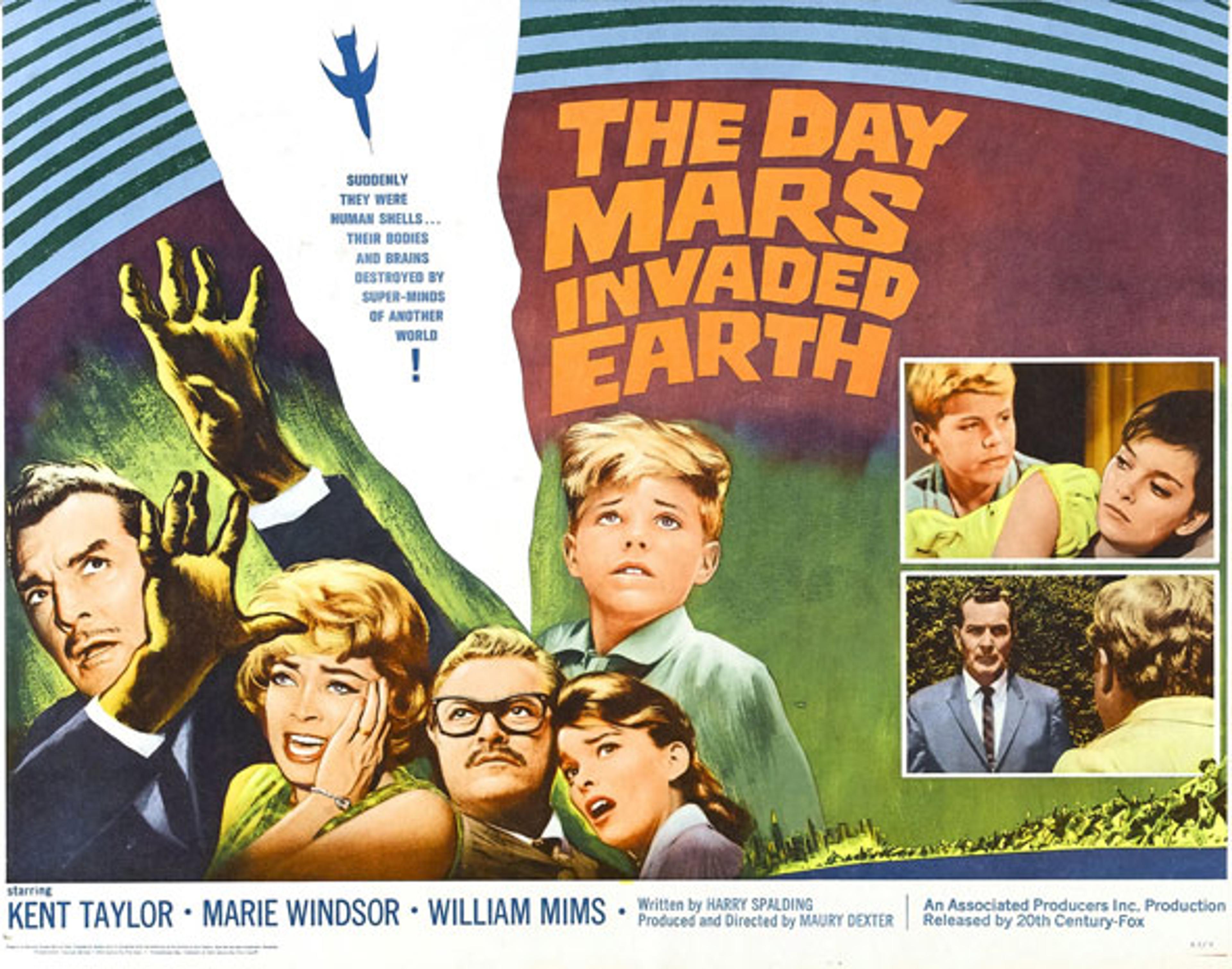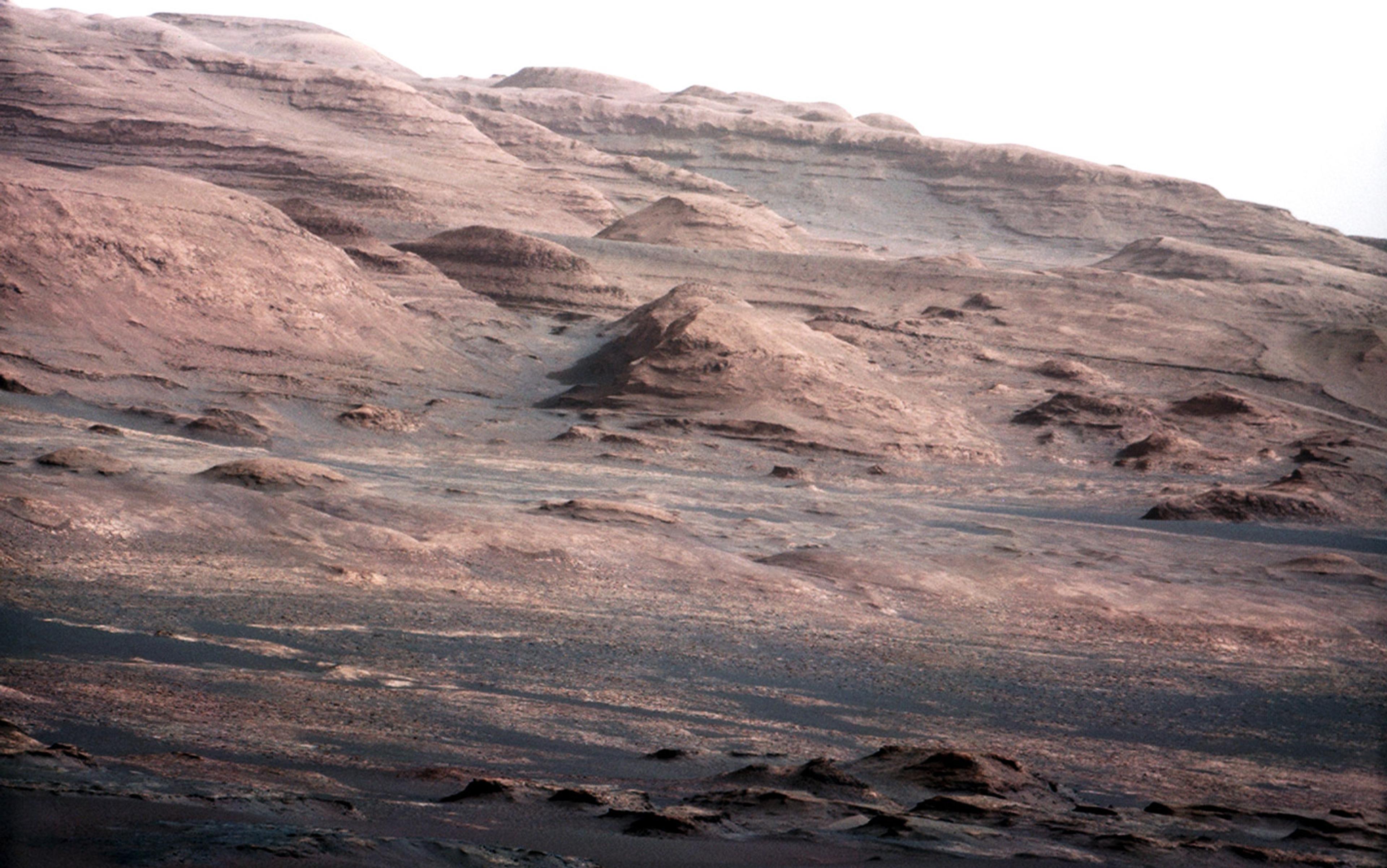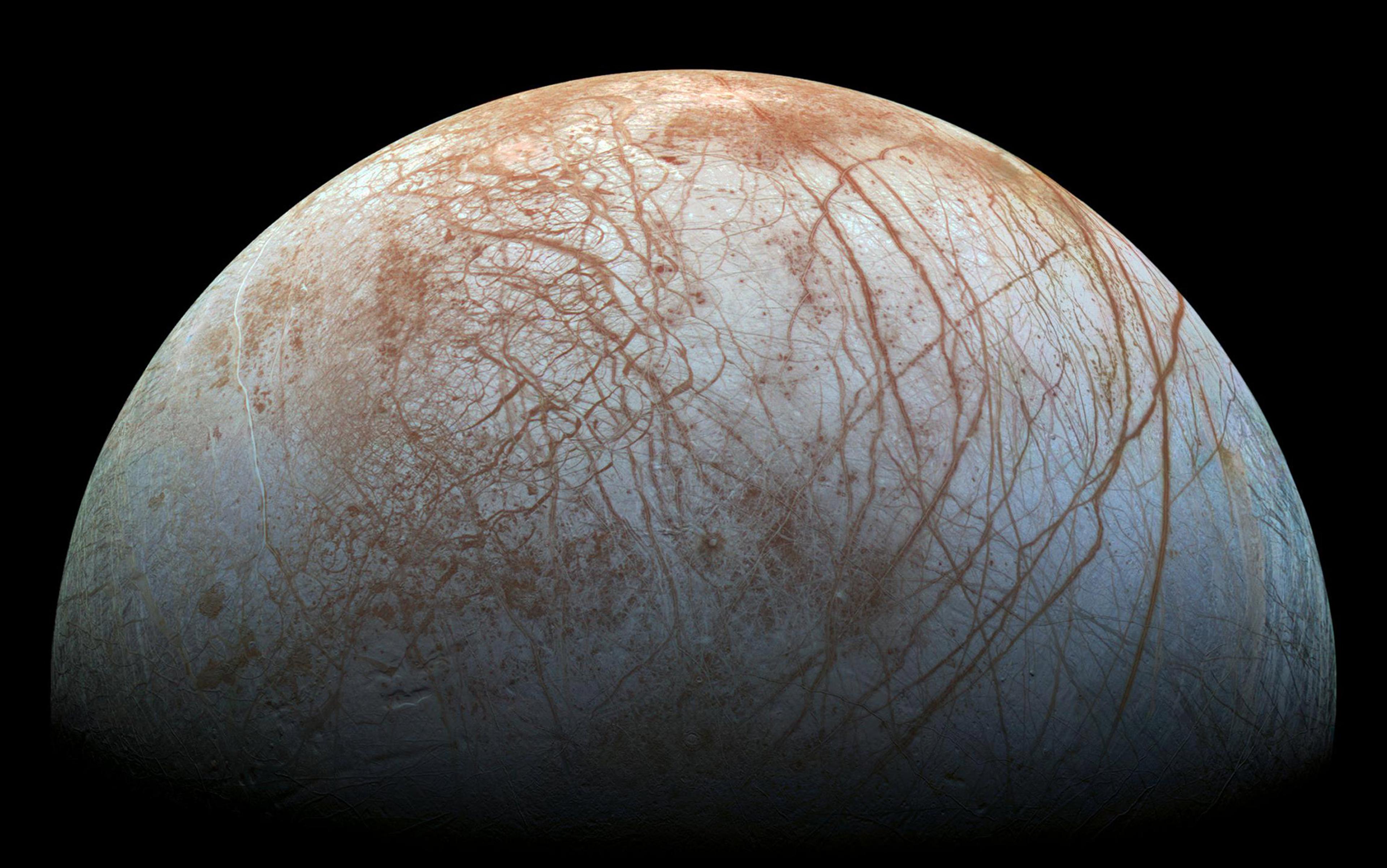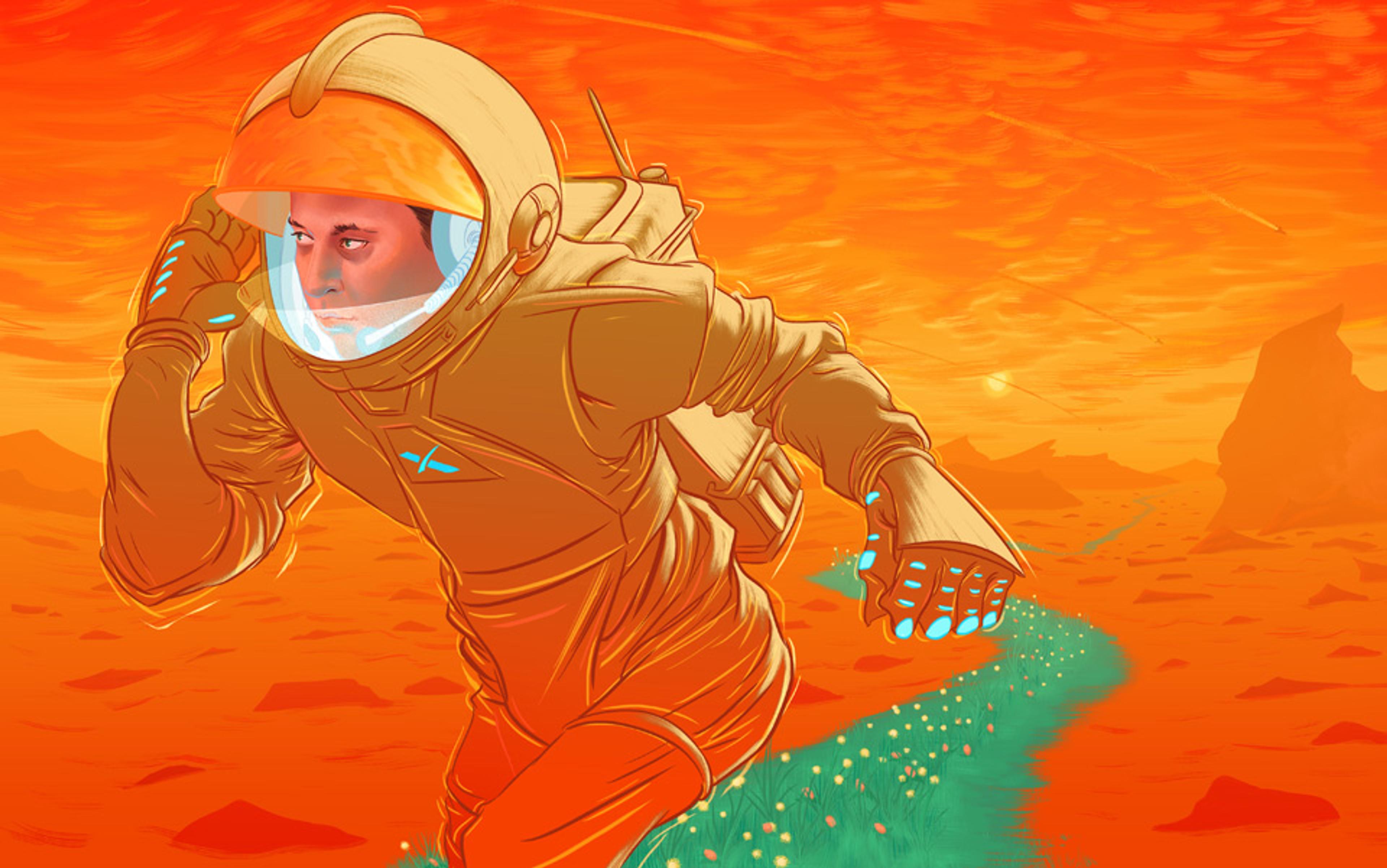Above, a washed-out, butterscotch sky that fades to a deep lazuli blue at dusk. At noon the sunlight is unforgiving, harsh, almost undiminished by its passage through 100km of near-vacuum and smoke-thin haze. The frigid nights are black and clear, the constellations familiar, the Milky Way magnificent. Only the absence of our baleful Moon (replaced by two brilliant lights skittering across the sky), and the twilight presence of a strange blue-green ‘star’ as bright as Sirius, betray this as an alien firmament.
This is Mars. It is a world away from, say, the Moon; a real place, not a rock. ‘Magnificent desolation’ was what Buzz Aldrin found on the lunar surface, and while lots of Mars may be magnificent, it is, in places, far from desolate. The first probes sent to land were directed at the dullest spots the scientists could find. Dull means flat, which means safe. That’s why the Vikings that landed in 1976 beamed back vistas of bleak, rubble-strewn plains.
But now NASA is going sightseeing, confident enough to land its precious robots in more rugged terrain. Curiosity, the latest probe to land on Mars, came screeching from the sky to land in the spectacular Gale Crater in August, right next to Mount Sharp, a three-mile-high peak of layered, red strata that looks for all the world like the rocks of the Grand Canyon.
Curiosity — nuclear-powered, the size of a Ford Focus, costing $2.5 billion and built to last into the 2030s — has already made waves. It has photographed what looks like a slab of conglomerate, a rock made of pebbles glued together with solidified mud. On Earth such rock tends to form in rivers or in undersea currents. Cue excitement. More excitement still when, a week later, Curiosity generated a teasing rumour that it had discovered evidence of life. That set the internet alight. But when these rumours coalesced into facts, revealed at a scientific meeting last month, things became no clearer. Cue yet more speculation.
If anything goes to show that data do not equal knowledge, let alone understanding, it is the curious case of Mars, a planet about which we humans have been having more or less the same arguments for nearly a century and a half. And despite intensive observation from Earth, from space and now on the ground of Mars itself, we seem to be as far away as ever from answering the three great Martian questions. What sort of place is this strange red world? Does it support life? Is this a planet we could ever make our home? And so, as Curiosity begins its long trek to the flanks of Mount Sharp, we, the residents of the third planet from the Sun, continue our love affair with the fourth.
Mars has fascinated humans for centuries. Through the naked eye it is, at best, a bright red dot, yet through a telescope it resolves itself into a world. It is the only planet whose solid surface can clearly be seen from Earth. The Martian day is much the same as ours (just 37 minutes longer); it even experiences four distinct seasons, equinoxes and solstices. The Franco-Italian astronomer Giovanni Domenico Cassini saw ice at the poles in 1666. The colours of Mars change throughout its 687-day year, suggesting (as was thought) great waves of vegetation bursting into life then dying back as the winter came. It is smaller than the Earth, yet even this difference is trumped by a final coincidental similarity: bereft of oceans, the surface area of Mars is almost identical to that of all the dry land on our planet.
Since its first identification as a planet, Mars has been the repository for fantasies and projections. From the late 19th century onwards, ‘Mars fever’ took hold, an Oz-like whirlwind of observation, fantasy and conjecture focusing on a Red Planet that was often imagined as an (even) bleaker version of Kansas. A century before Steven Spielberg, Stanley Kubrick and Ridley Scott created the modern cinematic extraterrestrial, the idea that Mars was home to alien life was taken for granted.
Were the canals we could see actual watercourses? Or were we seeing the bands of vegetation that covered the banks?
The fever really began in 1877, when the Italian astronomer Giovanni Schiaparelli thought he saw a lacelike network of lines on the Martian surface. He called them ‘canali’, meaning ‘channels’, but everyone else assumed he meant ‘canals’ — possibly because canals (Suez, Panama) were big news on Earth in the 1880s and ’90s. The Bostonian millionaire Percival Lowell built himself an observatory atop a hill near Flagstaff and used a powerful telescope to explore these Martian waterways. He spent night after cold night in the 1890s sketching them out, musing about the nature and motives of their builders. At the same time, the British writer HG Wells, unaware of Lowell’s work, was imagining a desiccating Mars, home to warlike aliens who coveted our watery world.

Alien nation: The Day Mars Invaded the Earth, 1963. Courtesy 20th Century Fox
In the early years of the 20th century, the science and the fictions about this planet became interchangeable. Wells’s aliens — and later princesses, monsters and warriors — seemed as real as the rings of Saturn. Were the canals we could see from Earth actual watercourses? Or were we seeing the bands of vegetation that covered the banks, just as, from space, the Nile appears to be a 50-mile-wide band of green? By common consent, the Mars of roughly 1910 was warm, wet and inhabited. There were only a few dissenting voices.
Among them was the British astronomer Agnes Clerke, who pointed out, in 1896, the awkward fact that many of these canals would have to flow uphill. She was joined by Alfred Russel Wallace, co-discoverer of evolution by natural selection. In 1908, he had taken one look at what was actually known about Mars (rather than the speculation) and dismissed the idea of canals and canal-builders out of hand. Far too cold, he said, and dry; ‘wholly incompatible with the existence of animal life’. He was right, but no one took any heed, least of all Lowell, who wrote a furious letter to Nature to complain about Wallace’s impertinence.
It is popularly supposed that Lowell’s Mars died in July 1965, with the arrival of the NASA space probe Mariner 4. Its camera showed a cratered, dry planet and no canals. The sceptics, from Clerke onwards, were proved right. No Martians, no warriors, no princesses.
And yet Lowell’s Mars never really died at all. In the archives at his old observatory I found an extraordinary map of Mars, prepared by cartographers at the United States Air Force to aid future exploration. It shows the ice caps, the patterns of dark and light and so forth. It also shows, in faint traces, the canals. The map was drawn in 1967, three years after it had been proven by Mariner 4 that the canals were a myth, the figment of a lot of wishful thinking and poor eyesight. So, like the IRA, the canals of Mars haven’t really gone away. It is fair to say (although no one at the agency will admit it) that, without those fictitious canals, there might never have been a NASA Mars programme.
They are still looking for them to this day. Not literally, perhaps, but the motto of the new Mars programme is ‘follow the water’. The hunt is still on for watercourses, frozen oceans, gullies and springs. Meanwhile, the ‘warm wet Mars’ that, in Victorian times, was thought to be current has been transposed back three aeons through time.
In late August 2003, Mars made its closest approach to Earth for more than 59,000 years. It came within 35 million miles of us, and it will not blaze that bright in our sky again until 2287. The Great Martian Opposition, as it became known, generated its own myths and legends, not least a bizarre internet rumour that it would loom as big as a full Moon. I was in the town of Flagstaff in Arizona at the time, hoping to get a peek at Mars through Lowell’s old telescope. His wonderful steampunk contraption of brass, iron and glass sits atop Mars Hill, a couple of miles outside town.
I was not alone. I had spent the evening drinking in a Flagstaff bar with Richard Hoagland, one of the oddest characters in Martian history. He is one of the world’s most prolific conspiracy theorists. His books detail how NASA had ‘hidden’ (clearly not very well) evidence that Mars is inhabited to this day. He insists that on 25 July 1976, one of the twin Viking orbiters took a picture of a sphinxlike ‘face’ carved into a low hill in the Cydonia region of the Red Planet. Hoagland’s website, the Enterprise Mission, is full of barmy eccentricities, photographs ‘showing’ bits of machinery on the Martian surface and orbital shots glimpsing ‘cities’ and other artefacts. Just uttering his name is enough to make proper scientists splutter into their drinks. All the same, I found him charmingly eccentric rather than sinister. I didn’t buy a word of what he said, of course, but telling him as much seemed pointless — it would be like arguing the toss with a Druid.
As we sat nursing our drinks, the skies cleared and Mars shone into view. Together with one of the Observatory staff we raced up the hill to Lowell’s telescope and took it in turns to peer through its century-old lenses at Lowell’s Mars. I don’t know what Hoagland saw; I certainly saw no canals. Even with a powerful refractor such as this, Mars appears no bigger in the eyepiece than the Moon does to the naked eye. How all those astronomers saw canals, let alone cities and ‘waves’ of vegetation heaven only knows. Then again, everyone who looks at Mars sees something different.
The serious exploration of Mars began half a century ago, with the launch of what became a small armada of American, Soviet and European space probes. Of the 44 spacecraft aimed at Mars to date, many failed — leading to talk of ‘a Martian Ghoul’ — but in recent years the ghoul has been vanquished and recent missions have for the most part been spectacular successes. Since the 1965 Mariner 4 fly-by, a total of 14 spacecraft have passed by Mars or entered orbit. Seven robots have landed on its surface. Human proxies have now photographed, prodded, poked, sniffed and tasted the planet’s sands, rocks and dusts.
We now have better maps of Mars than we had of Earth until surprisingly recently. Indeed, since most of the Earth’s surface is under a mile or more of water, we arguably have better maps of Mars than of Earth to this day. In the summer of 1976, the twin Viking probes sent back the first colour images from the surface. Twenty-one years later, Sojourner, a little six-wheeled probe, became an early internet hit. The Viking orbiters, Mars Global Surveyor and the European Mars Express (mother ship of the ill-fated British Beagle 2 lander), have taken extraordinary slews of photographs from orbit.
So what do we know? Mars is cold, dry and almost airless. Temperatures are on a par with the Antarctic, although it can get as warm as 15C at noon at the Equator. There is no standing water on its surface, no rivers, no lakes and no seas. It never rains but it does occasionally snow. The atmosphere is almost pure carbon dioxide, at a pressure of about one per cent of Earth’s at sea level. A naked astronaut would simultaneously freeze, suffocate and suffer fatal decompression after a minute or two. Mars is less hostile than the Moon, but only just.
The planet is the same age as the Earth and made of much the same stuff, albeit with important differences. Earth’s crust is constantly being remodelled by the forces of plate tectonics. They power volcanoes and earthquakes, thrust mountain ranges upwards and propel the continents around in 100-million-year dances. Mars has volcanoes but they all appear to be dead. There are no tectonic plates. And of course life has left its own mark on Earth, which is unsurprising when you think of the outer few miles or so of our planet as a sort of watery, biological-rocky gloop. Huge amounts of carbon dioxide are sequestered by marine organisms and turned into chalk and limestone. Without plankton, Earth would be a lot hotter — too hot for life, perhaps, or even for oceans. James Lovelock, the father of the Gaia hypothesis, says that Earth’s organisms act as a self-regulating mechanism. He sees no sign of that on Mars. ‘No life there,’ he once told me. ‘If there was it would be a very different place.’ Others disagree.
Martian microbes, blasted off the surface by meteor impacts, might well have been the ancestors of all Earthly life. In that case, we would all be Martians
We know that Mars was once rather different. Huge channels — not canals, but meandering courses that look like the arroyos of the American West — scar its surface. We think most of them formed between four and three billion years ago, although some might be younger. The majority view is that water carved these canali at a time when Mars was much warmer and wetter than it is today. There is still plenty of water on Mars in frozen form, at the poles and under the soil at high latitudes. The only evidence of liquid water, however, is a few gully-like structures that have been spotted from orbit.
Most Mars scientists believe that, if you could visit the Mars of three billion years ago, you would find a remarkably Earthlike world. It would have been covered in rivers and lakes, perhaps even whole oceans. Such an early Mars would have been an ideal place for life to evolve. The British cosmologist Paul Davies, professor at Arizona State University, has even suggested that, since Earth was rather inhospitable at this time, Martian microbes, blasted off the surface by meteor impacts with enough oomph to make it across the interplanetary void, might well have been the ancestors of all Earthly life. In that case, we would all be Martians.
But there are problems with this hypothesis. And because it is the promise of discovering an early warm-wet Mars that drives the NASA programme, it isn’t always popular to point out those problems. The most serious stumbling block is the ‘young, cool Sun’ problem. Four billion years ago, the Sun was about 30 per cent smaller and cooler than it is today. To make Mars hotter than it is now — by about 70 degrees — would require some serious atmospheric tinkering. A thick blanket of carbon dioxide would just about do it, but that poses the question of where all this gas could have gone in the meantime. On Earth, shellfish and plankton turn excess CO2 into carbonate rocks, chalk and limestone. Even if such organisms once proliferated on Mars, we see no evidence of the huge amounts of carbonate that would indicate such a scenario. There are no white cliffs on the Red World.
The fact is, we don’t really know what the early Mars was like. Chris McKay, a NASA planetary scientist, talks of a ‘cold wet’ early Mars — a planet that, at best, had a climate like that around the fringes of the Antarctic. It would have been deep-frozen most of the time, with periodic, short-lived melting episodes. Nick Hoffman, a geologist working in Melbourne, championed this ‘White Mars’ hypothesis in the early 2000s. He rejected the idea of Martian rivers and oceans altogether, replacing them with erosive carbon dioxide. This, I should make clear, is a minority view. Nevertheless, Hoffman was almost certainly right when he told me that astronomers are looking at Mars ‘through blue-tinted spectacles’. Lowell’s shadow is long indeed.
Of course, the big question concerns life. There is no doubt that the world of planetary science wants there to be life on Mars. Is this odd? Not really. It would make it a more interesting place. In fact, if we discover evidence of genuinely alien and indigenous biology on Mars, we would have to conclude on the grounds of probability that life must be more or less everywhere. And that makes the Universe itself a far more interesting place.
But also a rather disquieting one. A Martian biosphere would hugely deepen the Fermi Paradox, the ‘Where is everybody?’ question first posed by the physicist Enrico Fermi in 1950. Given the size and antiquity of the Universe, the discovery of life on the first planet we looked at would make the absence of any obvious signs of alien intelligence in the Universe at large even more mysterious than Fermi thought.
Given all that, it is rather odd that, for more than a quarter of a century, NASA has been doing its best not to look for life on Mars. To date, the only concerted attempt to see if there are living microbes on the Martian soil took place in 1976, when the two Viking landers performed a series of life-detection experiments. In the first, called ‘labelled release’, a scoop of Martian soil was placed in a container and mixed with a nutrient broth — water containing salts, sugars and so forth. The nutrient molecules were ‘tagged’ with radioactive Carbon-14. The air above the sample was then monitored for radioactive CO2 gas — evidence that the carbon in the nutrients had been metabolised by something alive in the soil and then excreted during respiration. To everyone’s surprise, the experiment elicited a strong positive result. A tentative declaration of ‘life on Mars!’ was made and the Champagne was taken out of the fridge.
Curiosity’s chief scientist John Grotzinger told an NPR journalist that the rover had found something ‘for the history books’
Then things took a strange turn. Another Viking experiment, designed to test for organic compounds in the Martian soil, came up negative. This was doubly surprising. Firstly, the labelled release seemed to suggest that there was carbon-utilising biology present. Secondly, even if there is no life at all, the surface of Mars should contain some organic molecules. They are ubiquitous in space, and rain down on every planet in the Solar System via meteorites.
And so the complete absence of organics not only appeared to negate the labelled release experiment; it also required explanation in itself. After the Champagne had been put back on ice, scientists speculated that the Martian soil contained chemicals that actively broke down organic compounds — something like hydrogen peroxide would do the trick. Gil Levin, the scientist behind the labelled release experiment, doggedly maintained that the positive biological finding was still valid. Nevertheless, the consensus was now that Viking had not detected life on Mars.
Yet the case was far from closed. In 1984, a meteorite called ALH84001 was discovered in Antarctica. It was known to have come from Mars, and in 1996 it was found to contain what looked very much like fossil bacteria. Then it transpired that the Viking organic-detection experiment had not worked properly after all. The obvious thing to do would be to send an updated version of the Viking life-detectors on another probe and run the 1976 experiments again. This is something that NASA has, in my opinion perversely, declined to do.
At a conference in San Diego last year, I asked Michael Meyer, head of NASA’s Mars Exploration Program, why no such experiment would be carried on-board Curiosity. We had heard that the rover was designed to discover whether Mars offers, or ever has offered, ‘conditions capable of supporting life’. But not life itself. Why not? Finding life, Meyer told me, ‘was a needle in a haystack’. Since we do not know what sort of biology there might be out there, it was better to look for circumstantial evidence — things like favourable geology and evidence of benign climates in the past. Fair enough, but plenty of people still think it was crazy not to put a life-detector on Curiosity.
Then came the internet rumours that erupted a few weeks ago. In an interview on 20 November 2012, Curiosity’s chief scientist, John Grotzinger, told an NPR journalist that the rover’s on-board chemistry set had found something ‘for the history books’. We knew this could not be life itself, since Curiosity was pointedly designed not to look for microbes. But it could be organics. Everyone at NASA was keeping schtum, so I rang Colin Pillinger, the man behind the failed Beagle 2 lander (which did carry a microbe detector) to see what he’d heard. ‘Organics of some kind,’ he said. And so it proved.
At a meeting of the American Geophysical Union in San Francisco on 3 December, the ‘historic’ results were revealed. Curiosity had indeed detected chlorinated carbon compounds in a sample of Martian soil. If the carbon is Martian, rather than a result of Earthly contamination, this would indeed be historic: there would no longer be any reason to doubt the positive biological findings from Viking all those years ago.
And so it goes. Everything we learn about Mars throws up a new load of questions. Nothing is as it seems. There seems to be life, but then there are no organics — hang on a minute, yes, there are! There are clays (warm, wet stuff) but, again, hang on a minute, they might be volcanic. There are streams that might be lava channels, lava channels that could be streams. Meteorites that might, or might not, contain the remnants of ancient Martian bugs. My guess is that we will only get to the bottom of these questions when we go to Mars in person. Until then, this planet, Earthlike in so many ways and alien in so many others, remains Terra Incognita. We can draw anything that takes our fancy in its red sands.






